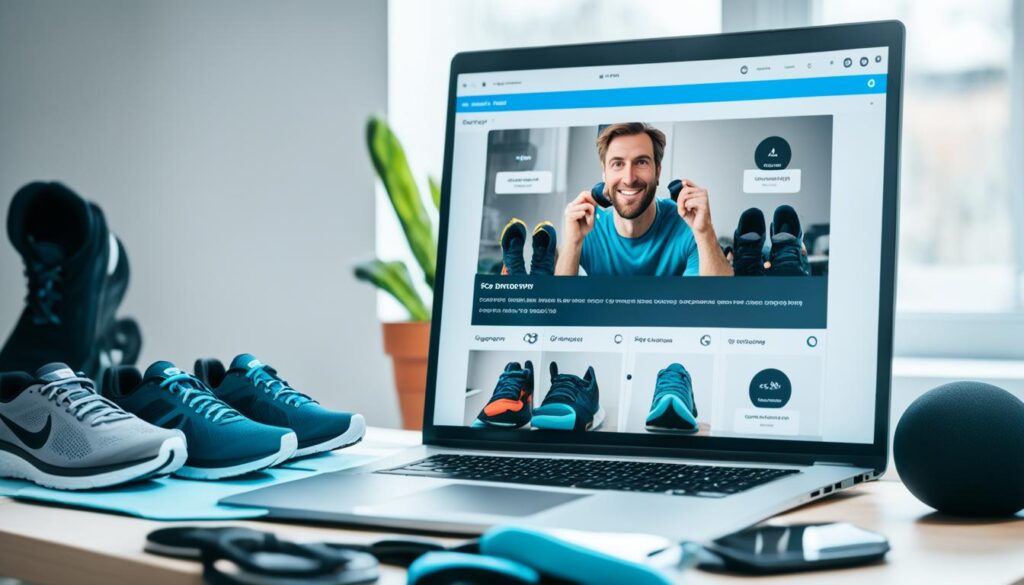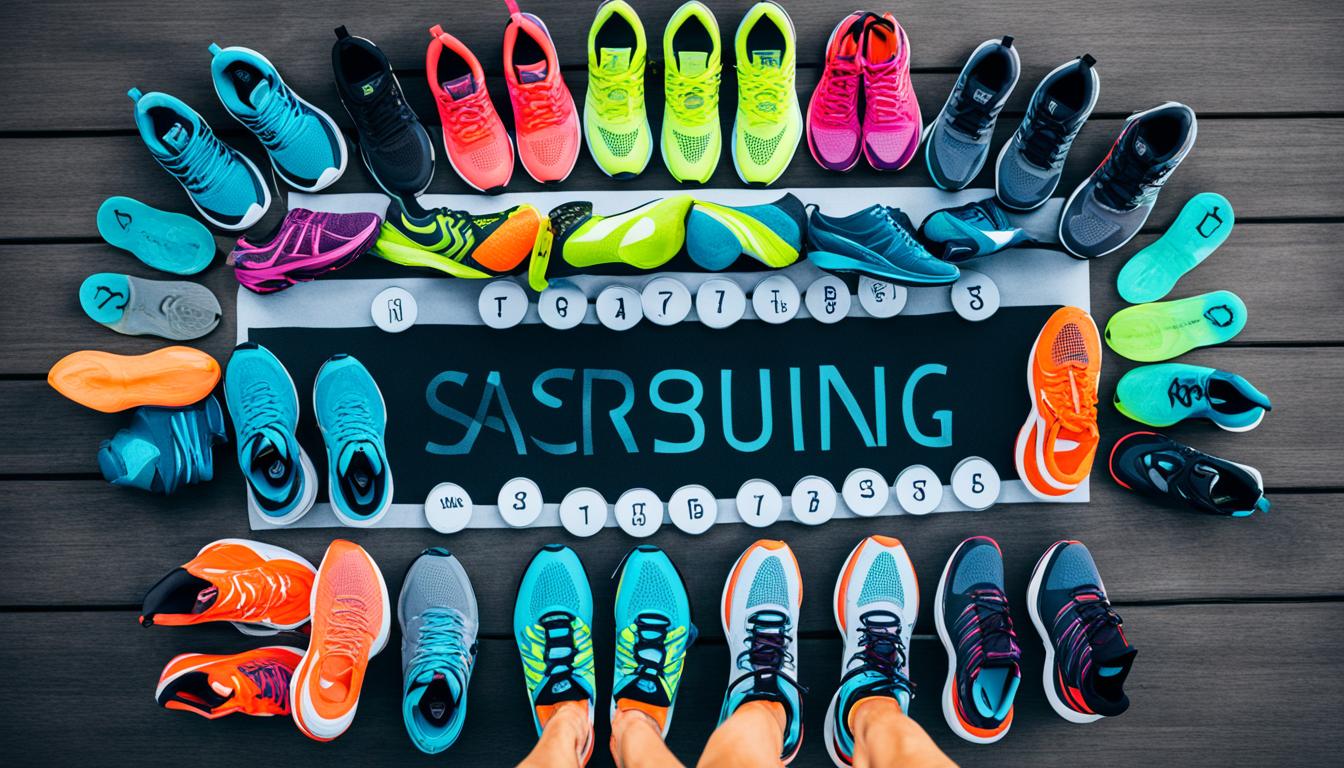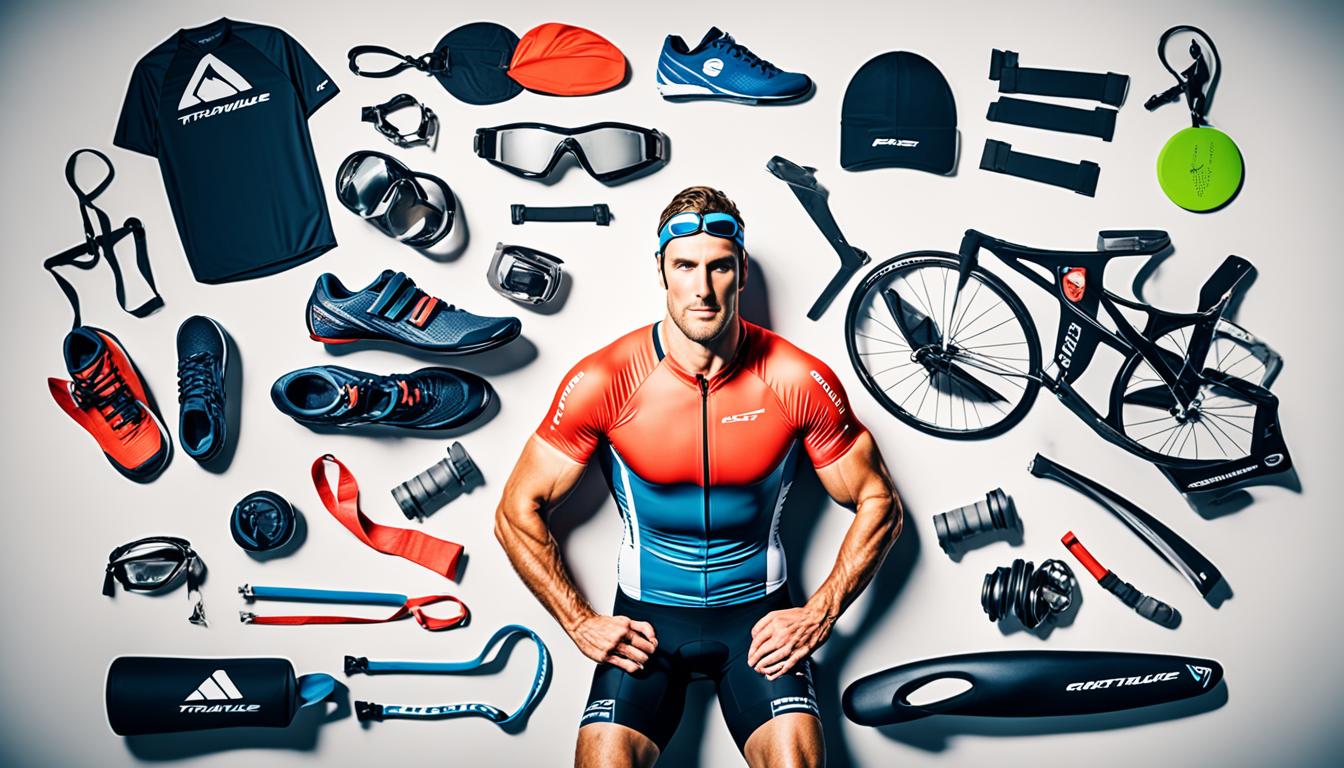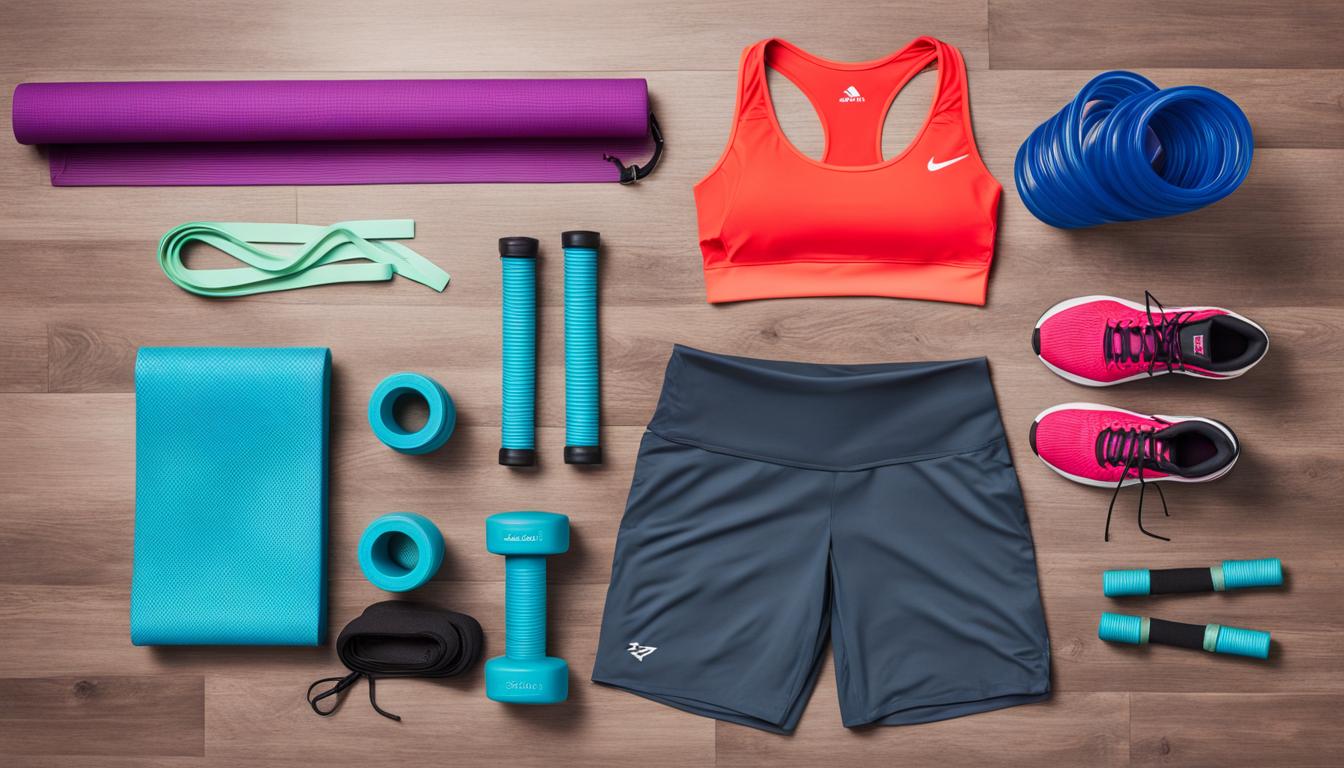Finding the perfect running shoe can seem tough with so many choices available. Brands, styles, and features vary widely. We’re here to help you pick the best running shoe for your needs and improve your performance.
Key Takeaways:
- Understanding the anatomy of a running shoe is essential for making an informed choice.
- Consider your running style, foot mechanics, and the surface you primarily run on when selecting a shoe.
- Ensure the shoe provides adequate support, cushioning, and fits comfortably.
- Test the shoes by taking them for a run before making a purchase.
- Focus on functionality and fit rather than brand or trends.
Understanding Shoe Anatomy and Fit
Finding the perfect running shoe is key. It must fit well and enhance your run. Let’s look at the parts of a running shoe:
The Upper
The upper part uses mesh or synthetic fabrics. It surrounds the top of your foot comfortably. A good upper means your foot breathes well during runs.
The Ankle Collar
The ankle collar cushions and supports your heels. It keeps your ankle steady and prevents injuries. A snug ankle collar gives a secure feel.
The Heel Counter
The heel counter at the shoe’s back stabilizes your heel. It stops too much pronation or supination. A solid heel counter also helps your running form.
The Saddle
The saddle covers your foot’s arch. It ensures a secure fit. An adjustable saddle fits various foot shapes and arches.
The Toebox
The toebox is where your toes go. It needs to be spacious for toe movement. A big toebox reduces blisters and discomfort on long runs.
Consider the running surface and shoe features like outsole and cushioning. Different shoes match different running styles. Choose what’s best for you.
Now you know about shoe parts and fit. Next, we’ll find the right support and cushioning for your shoes.
Finding the Right Support and Cushioning
Choosing the perfect athletic shoe means focusing on support and cushioning. Every runner has unique needs. Understanding your foot mechanics and preferences is key.
1. Consider Your Pronation
Pronation is the foot’s natural inward roll during the gait cycle. Knowing your pronation type is crucial for choosing the right shoe. For most, neutral shoes provide the needed support and comfort. Yet, if you overpronate or supinate, consider stability or cushioned shoes.
2. Choose the Right Midsole
The midsole is key for cushioning and shock absorption. Think about the midsole’s thickness and materials. A thicker midsole means more cushion, while a thinner one feels more responsive. Different materials, like foam or gel, affect comfort and softness. Test various options to find your ideal cushioning level.
3. Focus on Heel and Forefoot Cushioning
Running puts stress on the heels and forefeet. So, picking a shoe with good cushioning in these areas is vital. Models with extra heel cushioning are great for shock absorption. Also, good forefoot cushioning helps if you have a pronounced forefoot strike. This ensures comfort and prevents strain during runs.
4. Find the Right Heel-to-Toe Drop
The heel-to-toe drop is the height difference between a shoe’s heel and forefoot. Choosing the right drop depends on personal preference, your run style, and foot mechanics. Some like a higher drop for extra support. Others prefer a lower drop for a more natural feel. Try different drops to see what works for you.
By looking at these aspects, you can find the shoe that fits your needs. Remember, every runner is different. What works for one may not work for you. The perfect athletic shoe blends personal choice, fit, and understanding your running mechanics. Spend time trying on different shoes, get expert advice, and test them on a run. This way, you’ll make the best choice for you.
| Support | Cushioning |
|---|---|
| Neutral Shoes | Provide balanced support for most runners |
| Stability Shoes | Designed for overpronators, offering additional support |
| Cushioned Shoes | Preferable for supinators, providing extra cushioning |
Analyzing Your Gait and Running Style
It’s key to know your running gait and style when picking the right shoe. This knowledge helps you understand how your foot moves. With this, you can choose wisely.
Two popular methods for gait analysis are video analysis and checking your shoe’s wear pattern. Video analysis lets you see your run in detail, helping spot any problems. This is possible at specialty stores or with a coach’s help.
“Analyzing your gait is like a detective investigating a crime scene. It provides essential clues to determine the type of support and cushioning your feet need.”
Looking at how your shoes wear down is another gait clue. Uneven wear might mean pronation issues. This helps you figure out if you’re an overpronator, underpronator, or neutral.
Overpronation
Overpronation means your foot rolls in too much. It can make you unstable and injury-prone. If you overpronate, find shoes with stability and support. Look for a firm medial post or denser material inside the shoe.
Neutral Gait
If your foot rolls slightly and stays aligned, that’s a neutral gait. You can be more flexible in selecting shoes. Think about cushioning, arch support, and comfort to match your preferences and style.
Underpronation (Supination)
Underpronation, or supination, occurs when the foot rolls outward. It can cause stability and shock absorption issues. If this sounds like you, opt for shoes with lots of cushioning. Shoes with a curved last or extra flexibility can also help.
By understanding your gait and style, you’re better poised to pick the right running shoe. Remember, body mechanics, foot shape, and what feels comfy are crucial, too. Always good to get expert advice from a specialist or podiatrist for your unique needs.
Key Takeaways:
- Knowing your running gait is crucial for selecting the best shoe.
- Video analysis or wear pattern checks offer valuable insights.
- Overpronators should look for shoes with stability and support.
- Neutral runners have a wider range of shoe options.
- Underpronators need shoes with cushioning and flexibility.
- Always consider your own needs and comfort when choosing a shoe.
Considerations for Specific Running Surfaces
When picking running shoes, think about where you’ll be running. Different surfaces need different shoe types to boost your performance and keep you safe. Let’s look at the shoe options for various surfaces:
Road-Running Shoes
Road-running shoes are made for paved places. They give cushioning and stability. This helps for a smooth run on roads and sidewalks. They’re best for urban street runners or those on well-kept paths.
Trail-Running Shoes
Love running off-road, like on dirt or rocky paths? Trail-running shoes are for you. They have deep tread for better grip and prevent slipping. They also protect and support your feet on tough terrains.
Cross-Training Shoes
For those who mix their activities, cross-training shoes work well. These shoes work for gym, balance work, and some running. They are stable, flexible, and cushioned. They’re good for various exercises, offering support for side-to-side movements.
Hybrid Running Shoes
Like both road and trail running? Check out hybrid running shoes. They mix features of both for grip and comfort. They work well on different terrains while keeping your feet comfortable. Hybrids are ideal for those who switch between city and trail running.

Always match your shoes with your running surface. This ensures the right pick, whether shopping online or in-store. Knowing your terrain helps choose the best shoes. This maximizes your running pleasure and effectiveness.
Factors to Consider Before Buying
Before you buy, think about a few things. It’s important to know how far you’ll run to choose the right shoe. For long runs, you need shoes with lots of cushioning for comfort and support. But for short runs, look for shoes that are more flexible. These help you move quickly and respond better.
Try the shoes before buying them. Run with them on a treadmill or in the store. This way, you can see if they are comfortable, fit well, and perform as you need. Trying them ensures they meet your needs and likes.
Getting the right fit is very important when picking a running shoe. Your shoe should fit nicely and give your toes room to move. A good fit stops blisters, discomfort, and injuries. It’s more important to choose shoes that work well for you than to pick them for style or brand. Though style matters, the right function and fit make running better and more satisfying.
Key Factors to Consider When Buying a Running Shoe:
- Determine the distance you’ll be running
- Test the shoes by running on a treadmill or in-store
- Ensure the shoe fits well and provides enough space for toe movement
- Focus on functionality and fit rather than brand or trends
By thinking about these points, you can choose the best running shoes. This ensures great performance and comfort during your runs.
Conclusion
Finding the right running shoe is key for your comfort and how you perform. To pick the best one, learn about shoe parts, think about where you’ll run, look at how you run, and focus on features like support. This will help you find the right shoe for you.
Try on many shoes and really test them before you buy. Choose what works for you, not just the famous brands. The main aim is to get a shoe that makes your runs better and helps meet your goals.
This ultimate guide gives you all you need to confidently pick your perfect running shoes. They’ll support you on every type of run. So, tie your laces, step out, and enjoy your most amazing run ever!
FAQ
How do I choose the right running shoe for me?
To pick the right running shoe, focus on several factors. These include the shoe’s design, the kind of support it offers, and how well it cushions your feet. It’s also smart to look at your running style and the type of ground you’ll run on. Knowing these things helps you find a shoe that boosts your running performance.
What are the important features to look for in a running shoe?
When selecting a running shoe, comfort and support are key. Look for a shoe that has a soft upper part and supports around the ankle. The heel should fit well, and the middle part of the shoe should hold your foot securely. A roomy toe area is also important. Don’t forget to check the material on the bottom of the shoe, its shape, and how cushioned it is to match your needs.
What type of support and cushioning should I choose for my running shoe?
Runners have different needs when it comes to support and cushioning. If you have a neutral stride, most shoes will work. But if your foot rolls inward too much, look for stability shoes. And if you need extra cushioning, there are shoes just for that. Choose your shoe’s cushion level and material based on what feels good to you.
How can I analyze my gait and running style?
You can figure out your gait and running style in two ways. Record yourself running to see how you move or look at your old running shoes to see where they’re most worn. This tells you if your feet roll in too much or if you need extra support from your running shoes.
What type of running shoe should I choose based on the surface I primarily run on?
Your running surface matters when choosing shoes. Use road-running shoes for pavement and trail-running shoes for off-road paths. If you work out in the gym or run on different surfaces, consider cross-training or hybrid shoes. This ensures the right grip and support for wherever you’re running.
What factors should I consider before buying a running shoe?
Think about how far you’ll run, shoe comfort, and the shoe’s purpose and brand. Always try them on and test them out before you buy. Focus on the fit, how the shoe functions, and what you like. This ensures you pick the best shoe for your runs.





